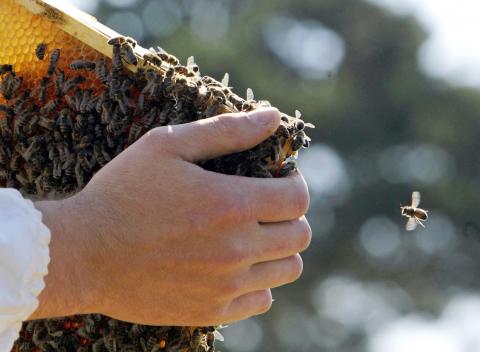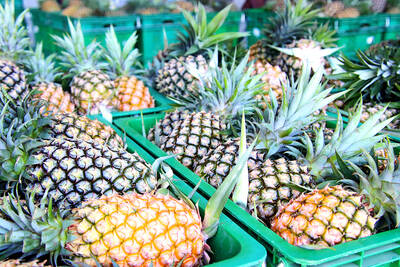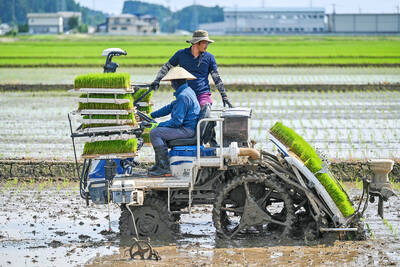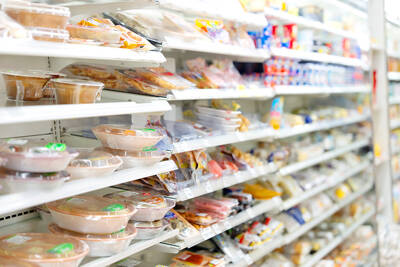Are you consuming real honey or fake honey? After testing a dozen different honeys being sold at supermarkets, hypermarkets and fruit stands, Taiwan Apicultural Society president and National Ilan University Biotechnology and Animal Science Department director Chen Yue-wen found that 75 percent were not real honey. Pollen could not be extracted from six of the honeys and three were a mixture of both fake and real honey. However, all products marked with official certification were up to standard. The Consumers’ Foundation has urged the government to require companies to be honest when listing the content of products.
Pure honey has no additives, Chen says, adding that much of the fake honey on the market is made up of high fructose corn syrup, caramel coloring and artificial flavoring. Many of the blended and synthetic honeys being sold on the market are actually a combination of pure and fake honey, and may meet the government’s Chinese National Standards (CNS). Chen has come up with a new method for analyzing stable isotopes in integrated biochemical processes, allowing one to accurately differentiate real from fake honey, which he will be presenting at the International Apicultural Congress at the end of the month.
Miaoli District Agricultural Research and Extension Station researchers Sung I-hsin and Wu Heui-hu say that not enough domestic honey is being produced to meet market demand, especially since production was cut in half this year, making it highly difficult to find pure Taiwanese honey at hypermarkets and supermarkets. They say that purchasing it directly from beekeepers would be the best way to get it. Taiwan Beekeepers Association chairman Wu Chao-sheng also says that domestically produced honey with certified labels is only sold at the Matsusei grocery store chain. While in the past there were a lot of fake honeys being sold, now food processing companies are buying pure honey from beekeepers and adding other ingredients, but he says that they should label the contents accurately.

Photo: Reuters
照片:路透
After reporters visited supermarkets and hypermarkets such as Pxmart, A.mart, RT-Mart and Carrefour, they found that none of the honey being sold at these stores had certified labels, and that all of the honey on sale, aside from two from Thailand, were from Taiwan. Carrefour and RT-Mart both add high-fructose corn syrup to their own brands of honey, which are marketed as “blended honey,” while A.mart does not label its honey this way. Some companies label their product as longan honey, but when you look on the back you see that it is actually blended honey. Causing much confusion, some companies even place pictures of beekeepers on molasses products.
A.mart says that of their company’s two longan honeys, one is 100 percent pure longan honey, while it is clearly labeled that the other one contains fructose and dextrose.
Tsai Shu-chen, chief of the Food and Drug Administration’s (FDA) food division, says that companies selling honey are not legally required to clearly state the contents of the product in product names unless it is being marketed as “pure honey.” But Consumers’ Foundation secretary-general Lei Li-fen says that the FDA requires labeling for milk powder, fruit juice and rice flour to indicate that the contents do not meet official standards by writing flavored milk powder, juice from concentrate or flavored rice flour. The standard should be the same for all products, says Lei.
Nutrition Foundation of Taiwan chief executive officer Wu Ying-jung says that fake honey does not have the nutrients that natural honey does, adding that eating too much high-fructose corn syrup can cause obesity, fatty liver disease and hyperuricemia, so not labeling such products clearly poses a potential danger to people with diabetes or metabolic syndrome.
(Liberty Times, Translated by Kyle Jeffcoat)
你喝的是「真蜜」或「假蜜」?台灣蜜蜂與蜂產品學會理事長、宜蘭大學教授陳裕文檢測超市、賣場與水果攤十二件蜂蜜,發現七成五摻假,其中六件無法萃取出花粉,三件屬真假蜜混合;至於有「國產蜂產品證明標章」的產品則檢驗全合格;消基會呼籲政府應要求業者誠實標示。
陳裕文解釋,純蜜沒有任何添加物,但坊間假蜜卻以高果糖糖漿、焦糖色素、香料製作而成,部分真假蜜混合的「調和蜜」、「合成蜜」還可能通過CNS(中華民國國家標準),他已開發出最新的穩定同位素結合生化檢測方法,可準確鑑別蜂蜜,月底將在世界蜜蜂大會發表。
苗栗農改場副研究員宋一鑫與吳輝虎強調,國內產量不敷市場需求,尤其今年產量少一半,要在賣場、超市買到國產純蜜很難,最好直接跟蜂農買。台灣養蜂協會理事長吳朝生也說,有證明標章的蜂蜜僅在松青超市鋪貨,而過去假蜜多,現在食品加工業者改向蜂農買蜜再添加其他成分,但仍應標示清楚。
記者走訪全聯社、愛買、大潤發、家樂福等賣場,全沒國產蜂產品證明標章,僅兩件產地為泰國,其餘為台灣。家樂福、大潤發自有品牌蜂蜜添加果糖等成分,有標示為「調和蜂蜜」,但愛買卻沒有。還有業者前面標示龍眼蜜,後面一看才知是調和蜜,甚至有黑糖蜜掛上養蜂照片,造成混淆。
愛買則說,公司有兩款自有品牌龍眼蜜,一款是百分之百龍眼蜜,另一款龍眼蜜成分有清楚標示有果糖和葡萄糖。
食藥署組長蔡淑貞表示,未強制規定蜂蜜品名標示,只要業者確實添加蜂蜜,但沒強調是純蜜,就不違法;但消基會秘書長雷立芬表示,食管署已要求奶粉、果汁、米粉如含量不足,就要標示為「調製乳粉」、「無果蔬汁」或「調合米粉」,標準應一致。
台灣營養基金會執行長吳映蓉表示,假蜜沒有天然蜂蜜的營養,高果糖糖漿吃太多會導致肥胖、脂肪肝、高尿酸,標示不清恐對糖尿病或代謝症候群患者有潛藏風險。
(自由時報記者鍾麗華、楊雅民)

A: What types of fruit enzymes should we take to help reduce eye floaters? B: According to a study published in the “Applied Sciences” journal by Taiwanese ophthalmologist Horng Chi-ting, pineapple, papaya and fig supplements can improve symptoms. A: Pineapples are in season now, so you should munch on more of those to get rid of floaters. B: Not quite. Enzymes can be damaged by our stomach acid if we eat the fruit directly. The doctor says taking fruit enzyme capsules is better for absorption. A: Most importantly, we should reduce our use of personal electronics to prevent floaters from

Rice is essential to Japanese culture, tradition and politics. People take pride in the oval-shaped sticky Japonica grain, which is still a staple even though total consumption has fallen over the decades. But since last summer, prices have soared as supplies have fallen short of demand. The government has long paid farmers to cut back on rice acreage, and change to other crops to keep rice prices relatively high. To cope with shortfalls this year, the government has released rice reserves. But the grain has been slow to reach supermarket shelves. Anger over that was part of the reason the Agriculture Minister

In Taiwan, 7-Eleven convenience stores can be found on almost every street corner. With over 84,600 stores across 20 countries, 7-Eleven has more locations than any other retail business on Earth. For millions of people, the chain is an important part of daily life, providing coffee, quick meals, and essential items for those __1__. The history of 7-Eleven began nearly 100 years ago in Dallas, Texas. In 1927, the Southland Ice Company began selling blocks of ice that were used to keep fridges cool. Shortly after opening, the company __2__ its offerings to include groceries like milk, eggs, and

Continued from yesterday(延續自昨日) https://www.taipeitimes.com/News/lang In 1946, the company adopted the name 7-Eleven to reflect its newly extended __3__, from 7am to 11pm, a novel concept at the time. As a rapidly growing company, it began offering franchise opportunities in the 1960s. In 1974, the first 7-Eleven in Japan was opened by the supermarket company Ito-Yokado. The Japanese franchises were __4__ successful that by 1991, Ito-Yokado was able to acquire a 70 percent stake in Southland Corporation. Its investments eventually resulted in full ownership of 7-Eleven, which paved the way for the Japanese company to enter the international market. Since then, 7-Eleven